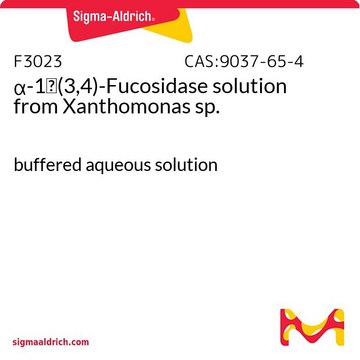H9908
Monoclonal Anti-phospho-Histone H3 (pSer28) antibody produced in rat
~0.5 mg/mL, clone HTA28, purified immunoglobulin, buffered aqueous solution
Synonym(e):
Monoclonal Anti-H3S28p
About This Item
Empfohlene Produkte
Biologische Quelle
rat
Qualitätsniveau
Konjugat
unconjugated
Antikörperform
purified immunoglobulin
Antikörper-Produkttyp
primary antibodies
Klon
HTA28, monoclonal
Form
buffered aqueous solution
Mol-Gew.
antigen 15 kDa
Speziesreaktivität
bovine, mouse, hamster, human
Verpackung
antibody small pack of 25 μL
Konzentration
~0.5 mg/mL
Methode(n)
flow cytometry: suitable
immunocytochemistry: suitable using 3.7% formaldehyde-methanol fixation
microarray: suitable
western blot: 0.5-1 μg/mL using whole extract of cultured human acute T cell leukemia Jurkat cells treated with Nocodazole.
Isotyp
IgG2a
UniProt-Hinterlegungsnummer
Versandbedingung
dry ice
Lagertemp.
−20°C
Posttranslationale Modifikation Target
phosphorylation (pSer28)
Angaben zum Gen
human ... H3F3A(3020) , H3F3B(3021) , HIST1H3A(8350) , HIST1H3B(8358) , HIST1H3C(8352) , HIST1H3D(8351) , HIST1H3E(8353) , HIST1H3F(8968) , HIST1H3G(8355) , HIST1H3H(8357) , HIST1H3I(8354) , HIST1H3J(8356) , HIST2H3A(333932) , HIST2H3C(126961) , HIST3H3(8290)
mouse ... H3f3a(15078) , H3f3b(15081) , Hist1h3a(360198) , Hist1h3b(319150) , Hist1h3c(319148) , Hist1h3d(319149) , Hist1h3e(319151) , Hist1h3f(260423) , Hist1h3g(97908) , Hist1h3h(319152) , Hist1h3i(319153) , Hist2h3b(319154) , Hist2h3c1(15077) , Hist2h3c2(97114)
Allgemeine Beschreibung
Spezifität
Immunogen
Anwendung
Biochem./physiol. Wirkung
H3 phosphorylation may contribute to proto-oncogene induction by modulating chromatin structure and releasing blocks in elongation. H3 dephosphorylation occurs quite rapidly after mitosis and serine-10/28 reo main unphosphorylated throughout the remainder of interphase. PP1 has been identified as the H3 phosphatase.
Physikalische Form
Angaben zur Herstellung
Lagerung und Haltbarkeit
Haftungsausschluss
Sie haben nicht das passende Produkt gefunden?
Probieren Sie unser Produkt-Auswahlhilfe. aus.
Lagerklassenschlüssel
10 - Combustible liquids
WGK
WGK 3
Flammpunkt (°F)
Not applicable
Flammpunkt (°C)
Not applicable
Analysenzertifikate (COA)
Suchen Sie nach Analysenzertifikate (COA), indem Sie die Lot-/Chargennummer des Produkts eingeben. Lot- und Chargennummern sind auf dem Produktetikett hinter den Wörtern ‘Lot’ oder ‘Batch’ (Lot oder Charge) zu finden.
Besitzen Sie dieses Produkt bereits?
In der Dokumentenbibliothek finden Sie die Dokumentation zu den Produkten, die Sie kürzlich erworben haben.
Unser Team von Wissenschaftlern verfügt über Erfahrung in allen Forschungsbereichen einschließlich Life Science, Materialwissenschaften, chemischer Synthese, Chromatographie, Analytik und vielen mehr..
Setzen Sie sich mit dem technischen Dienst in Verbindung.








